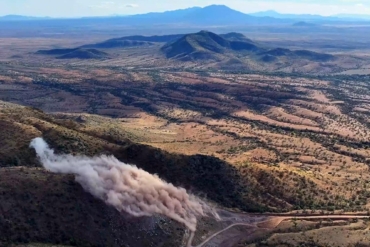Powder stashes, no crowds, a silent forest in winter: Tree skiing can be glorious. But with trees comes danger in the form of tree wells.

Experts claim tree wells are responsible for up to 20 percent of all ski deaths. Here are some pointers to stay out of harm’s way.
Tree Wells: A Hidden Danger
On the hunt for fresh Rocky Mountain pow, Boise resident Winston Goss and his son Ethan were skiing inbounds at McCall’s Brundage resort. With his dad trailing behind, Ethan popped off a snowy mound and tumbled headfirst into a tree well. Head buried in the snow, Ethan’s body weight pinned him face down, drowning in snow.
If it wasn’t for his dad’s quick thinking, Ethan could have easily become another statistic. Watch the video below for a spooky firsthand look.
What are Tree Wells?
Tree wells are pits of deep, soft snow that form around tree trunks in winter. As winter snow accumulates, low-hanging tree limbs create a protective canopy, preventing snow from compressing next to the trunk.
Because the snow is so soft and deep, a skier, snowboarder, hiker, or snowshoer who falls in headfirst usually cannot free themselves. With skis over their heads, they becoming trapped in the snow.
The situation compounds when dollops of snow collapse off overhead branches or off the tree well walls, further burying the victim. Eventually, people can suffocate in tree wells, a death officially called snow immersion suffocation (SIS).
How To Identify a Tree Well
Low-hanging tree branches often hide tree wells, making them hard to spot. It’s best to assume any tree is a potential hazard.
Where Tree Wells are Found
Tree wells can be found inbounds at ski resorts on ungroomed trails and off piste in the backcountry.
Also called “spruce traps,” they are most commonly found under evergreen trees—like hemlocks and fir trees—with low-lying branches that keep snow from compressing under the tree.
How to Avoid Tree Wells
Avoid skiing in trees. Skiing inbounds on consolidated, groomed runs pretty much guarantees you won’t find tree wells. That said, tree skiing is awesome, and you can do so safely with some of the tips below.
Be cautious after a storm. Most tree well accidents happen after a fresh dump of powder. If you are uncomfortable skiing in powder, stay out of the trees.
Ski defensively. Ski in control when skiing in the trees! If possible, choose a more open forest with room to ski around tree hazards. If it gets tight, slow down.
Don’t ski alone. According to researchers, 90 percent of skiers who fall in a tree well can’t get out by themselves. Ski with a partner and stay in sight of each other. If you lose sight, try to stay in touch audibly, and check in on each other regularly.
Bring the right equipment. Skiing ungroomed terrain usually means skiing with fewer people. Be self-sufficient. Even inbounds, consider bringing a beacon, probe, and shovel. A cell phone, whistle, and RECCO reflectors can also help inbounds. An Avi-Lung can give you precious extra minutes under the snow too (provided you can get the mouthpiece in your mouth).
Don’t assume you are too good for this to happen to you. SIS doesn’t discriminate. Looking at the statistics posted by the National Avalanche Institute, most of the incidents happen among intermediate-to-advanced skiers who ski with partners.
What to Do if Caught in a Tree Well
Try to keep from going down. Grab the tree, roll to the side, do what you can to keep from falling in the well.
Try to keep yourself upright. The leading cause of death is suffocation. The snow in the well is usually unconsolidated and hard to push out of. Boots and skis will weigh down your upper body, making it difficult to right yourself. So do what you can to keep your head above your skis so you can breathe and call for help.
Try to give yourself a pocket of air. Going down headfirst? Use your arms to try and create a little extra space. Even a little extra room can give you precious minutes of oxygen.
Stay calm. Conserve the limited oxygen supply and trust your friends will get you out quickly.
Worst-Case Scenario
Tumbling headfirst into a tree well puts the body in a compromised position. Arms trapped and head buried, you have little leverage to pry yourself out. The statistical risks of death are similar to those of people buried in an avalanche. With about 15 minutes of oxygen, the stats are grim.







